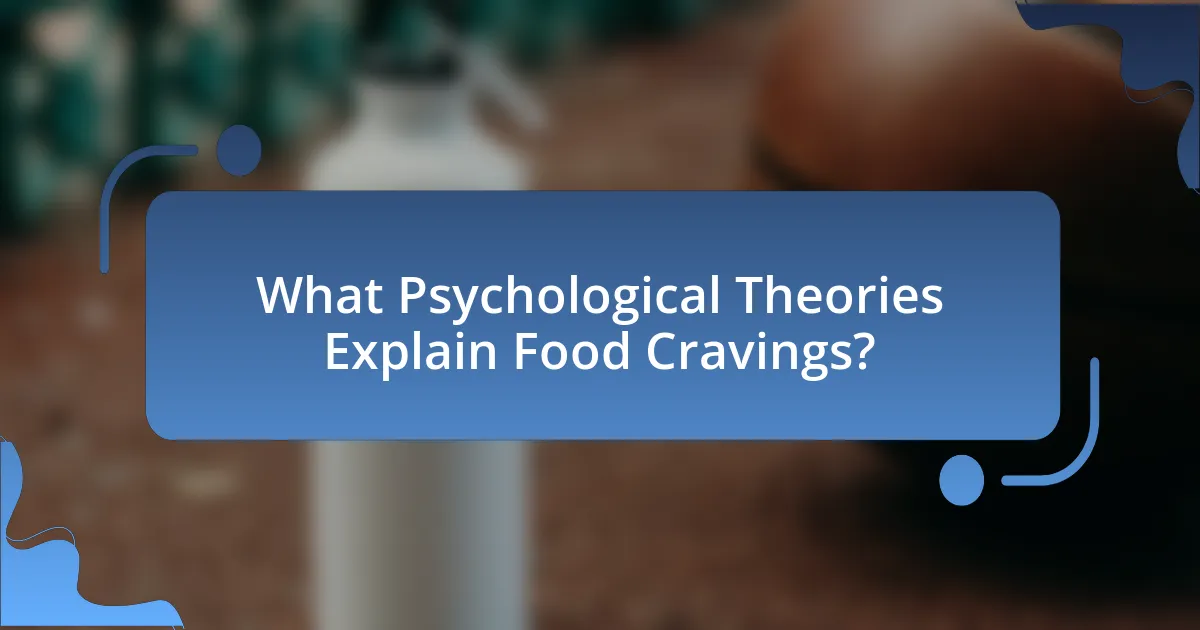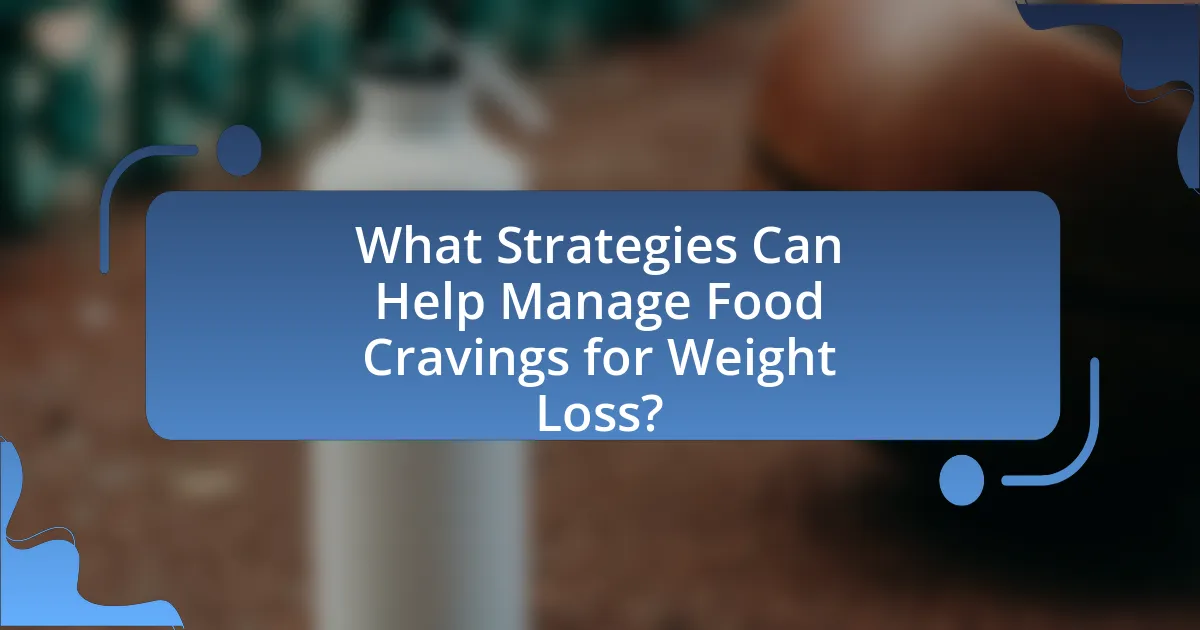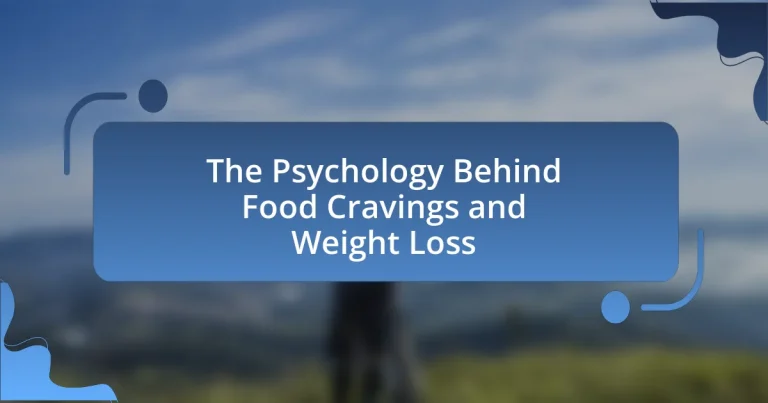The article explores the psychology behind food cravings and their impact on weight loss. It defines food cravings as intense desires for specific foods influenced by emotional, physiological, and psychological factors, which can lead to overeating and hinder weight management. Key discussions include the biological and psychological triggers of cravings, the role of emotions in food choices, and the influence of social and environmental factors. Additionally, the article outlines strategies for managing cravings, such as mindful eating, hydration, and balanced nutrition, emphasizing their importance in supporting effective weight loss efforts.

What are Food Cravings and How Do They Relate to Weight Loss?
Food cravings are intense desires for specific foods, often driven by emotional, physiological, or psychological factors. These cravings can significantly impact weight loss efforts, as they may lead to overeating or the consumption of high-calorie, unhealthy foods. Research indicates that cravings are linked to brain activity in areas associated with reward and pleasure, which can override satiety signals and lead to impulsive eating behaviors. For instance, a study published in the journal “Appetite” found that individuals who frequently experience food cravings are more likely to struggle with weight management, as these cravings can trigger binge eating episodes. Understanding the nature of food cravings and their psychological underpinnings is crucial for developing effective weight loss strategies.
Why do we experience food cravings?
We experience food cravings primarily due to a combination of biological, psychological, and environmental factors. Biologically, cravings can be triggered by hormonal changes, such as fluctuations in insulin and ghrelin levels, which influence hunger and satiety signals. Psychologically, cravings often arise from emotional states, where individuals seek comfort or pleasure from specific foods, particularly those high in sugar or fat. Environmental cues, such as the sight or smell of food, can also stimulate cravings by activating the brain’s reward system. Research indicates that these cravings can lead to overeating, impacting weight management and overall health.
What psychological factors contribute to food cravings?
Psychological factors that contribute to food cravings include emotional states, stress, and learned associations. Emotional states, such as sadness or boredom, can trigger cravings for comfort foods, which are often high in sugar and fat. Stress activates the body’s fight-or-flight response, leading to increased cravings for high-calorie foods as a coping mechanism. Additionally, learned associations, such as linking certain foods with specific experiences or rewards, can create strong cravings. Research indicates that these psychological triggers can significantly influence eating behavior and food choices, impacting overall dietary habits and weight management.
How do emotions influence our food choices?
Emotions significantly influence food choices by affecting cravings and preferences. For instance, individuals often seek comfort foods during stress or sadness, which are typically high in sugar and fat, as these foods can trigger the release of dopamine, a neurotransmitter associated with pleasure. Research published in the journal “Appetite” by van Strien (2018) indicates that emotional eating is a common response to negative emotions, leading to increased consumption of unhealthy foods. Additionally, positive emotions can enhance the enjoyment of food, leading to more indulgent choices. Thus, emotional states directly correlate with dietary decisions, impacting overall eating behavior and health outcomes.
How do food cravings impact weight loss efforts?
Food cravings significantly hinder weight loss efforts by leading to increased calorie intake and poor dietary choices. When individuals experience cravings, they often consume high-calorie, low-nutrient foods, which can derail their weight loss plans. Research indicates that cravings are linked to emotional states and can trigger overeating, making it challenging to maintain a calorie deficit necessary for weight loss. A study published in the journal “Appetite” found that individuals who frequently experience cravings are more likely to struggle with weight management, as they tend to give in to these urges rather than adhere to healthier eating patterns.
What role do cravings play in overeating?
Cravings significantly contribute to overeating by triggering intense desires for specific foods, often high in sugar, fat, or salt. These cravings can lead individuals to consume more calories than necessary, as they may prioritize immediate gratification over nutritional needs. Research indicates that cravings are linked to emotional states, such as stress or boredom, which can further exacerbate overeating behaviors. For instance, a study published in the journal “Appetite” found that emotional eating is closely associated with heightened cravings, leading to increased food intake. Thus, cravings play a crucial role in the psychological mechanisms that drive overeating.
How can understanding cravings aid in weight management?
Understanding cravings can significantly aid in weight management by allowing individuals to identify triggers and differentiate between emotional and physical hunger. Recognizing that cravings often stem from emotional states or environmental cues enables individuals to develop strategies to cope with these urges without resorting to unhealthy eating. Research indicates that mindfulness practices can reduce the intensity of cravings, leading to better food choices and portion control. For instance, a study published in the journal “Appetite” found that participants who practiced mindfulness reported lower levels of craving and made healthier food selections. By understanding the nature of their cravings, individuals can implement effective strategies to manage their eating behaviors, ultimately supporting their weight management goals.

What Psychological Theories Explain Food Cravings?
Psychological theories explaining food cravings include the cognitive-behavioral theory, which posits that cravings arise from learned associations between food and emotional states, and the incentive-sensitization theory, which suggests that cues in the environment trigger cravings by enhancing the desire for specific foods. Additionally, the affect regulation theory indicates that individuals may crave certain foods to manage their emotions, seeking comfort or pleasure. Research supports these theories; for instance, studies have shown that emotional states significantly influence food choices and cravings, highlighting the interplay between psychological factors and eating behavior.
How does the reward system in the brain affect cravings?
The reward system in the brain significantly influences cravings by releasing neurotransmitters, particularly dopamine, in response to pleasurable stimuli, such as food. This release reinforces the desire to seek out and consume those pleasurable foods, creating a cycle of craving and reward. Research indicates that when individuals consume high-calorie or sugary foods, the brain’s reward pathways become activated, leading to increased cravings for those foods in the future. A study published in the journal “Neuroscience & Biobehavioral Reviews” by Volkow et al. (2013) highlights how the brain’s reward circuitry can become dysregulated, contributing to overeating and obesity. This evidence underscores the critical role of the reward system in shaping food cravings and influencing eating behaviors.
What neurotransmitters are involved in the craving process?
Dopamine, serotonin, and norepinephrine are the primary neurotransmitters involved in the craving process. Dopamine plays a crucial role in the reward system, reinforcing behaviors associated with cravings by signaling pleasure and satisfaction. Serotonin influences mood and appetite regulation, affecting the desire for specific foods, particularly those high in carbohydrates. Norepinephrine is linked to arousal and alertness, which can heighten cravings during stress or emotional situations. Research indicates that these neurotransmitters interact in complex ways, influencing both the intensity and frequency of cravings, thereby impacting eating behaviors and weight management.
How does conditioning influence our food preferences?
Conditioning significantly influences our food preferences by creating associations between specific foods and experiences or emotions. For example, classical conditioning occurs when a person repeatedly consumes a particular food while experiencing positive emotions, leading to a preference for that food in the future. Research by P. J. McGowan and colleagues in the journal “Appetite” demonstrates that individuals often develop cravings for foods associated with rewarding experiences, such as celebrations or comfort during stress. This learned behavior can lead to a strong preference for those foods, impacting dietary choices and overall eating habits.
What cognitive biases contribute to food cravings?
Cognitive biases that contribute to food cravings include the availability heuristic, confirmation bias, and the framing effect. The availability heuristic leads individuals to crave foods that are easily recalled, often due to recent exposure or strong emotional associations. Confirmation bias causes people to seek out information that supports their cravings while ignoring contradictory evidence, reinforcing their desire for specific foods. The framing effect influences cravings based on how food options are presented, such as labeling a snack as “guilt-free,” which can enhance its appeal. These biases are supported by research indicating that cognitive processes significantly impact eating behavior and decision-making related to food.
How does the availability heuristic affect our food choices?
The availability heuristic significantly influences our food choices by leading individuals to rely on immediate examples that come to mind when making dietary decisions. This cognitive bias causes people to favor foods that are more readily recalled, often due to recent exposure or vivid experiences, over healthier options that may not be as top-of-mind. For instance, if someone frequently sees advertisements for fast food, they are more likely to choose those options when hungry, despite knowing healthier alternatives exist. Research indicates that this heuristic can skew perceptions of food availability and desirability, ultimately impacting dietary habits and contributing to unhealthy eating patterns.
What is the impact of social influences on cravings?
Social influences significantly impact cravings by shaping individuals’ perceptions and behaviors regarding food. Research indicates that social contexts, such as peer pressure and cultural norms, can enhance or diminish cravings for specific foods. For instance, a study published in the journal “Appetite” by Herman and Polivy (2008) found that individuals are more likely to crave high-calorie foods when in the presence of others who are consuming those foods, demonstrating the role of social modeling. Additionally, social gatherings often feature certain foods, reinforcing cravings through environmental cues and shared experiences. These dynamics illustrate how social influences can alter not only the intensity of cravings but also the types of foods individuals desire.

What Strategies Can Help Manage Food Cravings for Weight Loss?
To manage food cravings for weight loss, individuals can employ strategies such as mindful eating, staying hydrated, and incorporating high-fiber foods into their diet. Mindful eating involves paying attention to hunger cues and savoring each bite, which can reduce the likelihood of overeating. Staying hydrated helps distinguish between thirst and hunger, as dehydration can often be mistaken for cravings. Additionally, high-fiber foods promote satiety, making it easier to resist unhealthy snacks. Research indicates that these strategies can effectively reduce cravings and support weight loss efforts, as evidenced by studies showing that mindful eating can lead to a decrease in binge eating episodes and improved dietary choices.
How can mindfulness techniques reduce cravings?
Mindfulness techniques can reduce cravings by enhancing awareness of thoughts and feelings associated with those cravings. This heightened awareness allows individuals to recognize cravings as temporary sensations rather than immediate needs, which can diminish their intensity. Research indicates that mindfulness practices, such as meditation and focused breathing, can activate brain regions associated with self-regulation and emotional control, leading to a decrease in impulsive eating behaviors. A study published in the journal “Appetite” by Alberts et al. (2012) found that participants who practiced mindfulness reported lower levels of food cravings and were more successful in resisting unhealthy snacks compared to those who did not engage in mindfulness practices.
What practices promote awareness of hunger cues?
Practices that promote awareness of hunger cues include mindful eating, regular meal timing, and self-monitoring of hunger levels. Mindful eating encourages individuals to focus on the sensory experience of eating, which helps them recognize physical hunger and fullness signals. Research indicates that individuals who practice mindful eating are more attuned to their body’s hunger cues, leading to healthier eating habits and weight management. Regular meal timing establishes a routine that can help individuals better identify when they are genuinely hungry, reducing the likelihood of emotional or habitual eating. Self-monitoring, such as keeping a food diary, allows individuals to track their hunger levels and eating patterns, fostering greater awareness of their body’s needs. These practices collectively enhance the ability to respond appropriately to hunger cues, supporting healthier eating behaviors.
How does mindful eating change our relationship with food?
Mindful eating transforms our relationship with food by fostering awareness and intentionality during meals. This practice encourages individuals to focus on the sensory experience of eating, which can lead to improved recognition of hunger and satiety cues. Research indicates that mindful eating can reduce emotional eating and promote healthier food choices, as individuals become more attuned to their body’s needs rather than external cues. A study published in the journal “Appetite” found that participants who practiced mindful eating reported lower levels of binge eating and greater satisfaction with their meals, highlighting the positive impact of this approach on overall eating behavior.
What dietary changes can help mitigate cravings?
To mitigate cravings, individuals can incorporate more protein and fiber into their diets. Protein helps increase satiety and reduce hunger hormones, while fiber slows digestion and promotes fullness. Research indicates that diets high in protein can lead to a 15% reduction in cravings, as shown in a study published in the American Journal of Clinical Nutrition by Weigle et al. (2005). Additionally, consuming whole foods instead of processed options can stabilize blood sugar levels, further reducing the likelihood of cravings.
How does balanced nutrition influence craving patterns?
Balanced nutrition significantly influences craving patterns by stabilizing blood sugar levels and providing essential nutrients that reduce the likelihood of intense food cravings. When individuals consume a diet rich in whole foods, including fruits, vegetables, whole grains, and lean proteins, they experience fewer fluctuations in energy levels, which can lead to decreased cravings for high-sugar or high-fat foods. Research indicates that balanced meals, which include a combination of macronutrients, help maintain satiety and regulate hormones such as ghrelin and leptin, further mitigating cravings. For instance, a study published in the journal “Appetite” found that participants who consumed balanced meals reported lower cravings for unhealthy snacks compared to those who consumed unbalanced diets.
What role do hydration and sleep play in managing cravings?
Hydration and sleep significantly influence the management of cravings. Adequate hydration helps regulate appetite and can reduce the likelihood of mistaking thirst for hunger, thereby minimizing cravings. Research indicates that even mild dehydration can lead to increased feelings of hunger and cravings for high-calorie foods. Additionally, sleep plays a crucial role in appetite regulation; insufficient sleep disrupts hormones such as ghrelin and leptin, which control hunger and satiety, leading to heightened cravings for unhealthy foods. Studies have shown that individuals who sleep less than seven hours per night are more likely to experience increased cravings and make poorer food choices.
What practical tips can support weight loss while managing cravings?
To support weight loss while managing cravings, individuals can implement strategies such as consuming high-protein meals, staying hydrated, and practicing mindful eating. High-protein meals help increase satiety and reduce hunger, as protein has been shown to promote feelings of fullness more effectively than carbohydrates or fats. Staying hydrated can also curb cravings, as thirst is often mistaken for hunger; research indicates that drinking water before meals can lead to reduced calorie intake. Mindful eating encourages individuals to focus on their food, which can help them recognize true hunger cues and prevent overeating. These strategies are supported by studies demonstrating their effectiveness in weight management and craving control.


